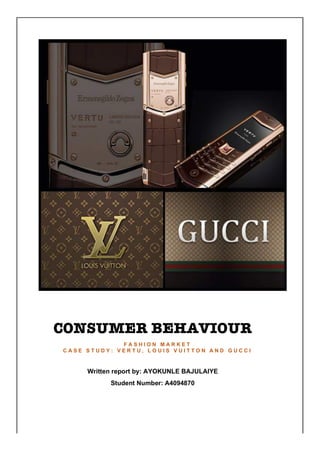This document provides a case study analysis of the consumer decision processes and behaviors related to the luxury fashion brands Gucci, Louis Vuitton, and Vertu. It begins with an introduction and background on the brands. It then examines the 5 stages of consumer decision making: need recognition, information search, evaluation of alternatives, purchase, and post-purchase evaluation. Specific to these brands, it analyzes their target demographics, the decision factors and motivations at each stage, including hedonic versus utilitarian needs and the influence of status and image. The document also discusses how the brands' physical retail environments influence the consumer experience and marketing strategies.











![12
References
Belch, G. E. and Belch, M. A. (2003). Advertising and Promotion: An Integrated Marketing
Communications Perspective 9th edn. New York: McGraw-Hill Irwin.
Bloemer, J. M. M. and Ruyter, K. (1997). On the relationship between store image, store
satisfaction and store loyalty, European Journal of Marketing, 499 – 513.
Boulding, K. E. (1970). Economics of Science. McGraw-Hill, New York.
Escalas, and Bettman, J. E. (2003). You Are What They Eat: The Influence of Reference
Groups on Consumer’s Connections to Brands, Journal of Consumer Psychology, 13(3):
339 – 348.
Hofstede, G. (2001). Culture’s Consequences. Thousand Oaks, CA: Sage Publications.
Jobber, D. (2009). Foundations of Marketing, 3rd edn. McGraw-Hill Higher Education.
Jones, S. (2014). The Six Stages of the Consumer Buying Process and How to Market to
Them. [Online]. Available at: http://www.business2community.com/consumer-
marketing/six-stages-consumer-buying-process-market-0811565 (Accessed on 11
October 2015).
Lindringde, A. and Dibb, S. (2003). “Is Culture a Justifiable Variable for Market
Segmentation? A Cross Segmentation? A Cross-Cultural Example”, Journal of Consumer
Behaviour, 2(3): 269 – 286.
Maslow, A. H. (1943). A Theory of Human Motivation, Psychological Review, 50(4): 370 –
396.
Mich, T. (2014). Luxury Mobile Phone Manufacturer, Vertu, Selects Altair’s HyperWorks
Unlimited Plug-and-Play Private Cloud Solution for Computer-Aided Engineering.
[Online]. Available at:
http://www.altair.com/newsdetail.aspx?news_id=11056&news_country=en=US (Accessed
13 on October 2015).
Pavarini, M. C. (2011). Gucci Introduces Immersive Retail Experience. [Online] Available at:
http://www.sportswearnet.com/news/pages/protected/GUCCI-INTRODUCES-
IMMERSIVE-RETAIL-EXPERIENCE--_4534.html (Accessed 1st October 2015).
Peter, J. P. and Olson, J. C. (2008). Consumer Behaviour and Marketing Strategy.
Singapore: McGraw-Hill.](https://image.slidesharecdn.com/2e73a0b5-8e38-4094-b86c-dd0be4a145bf-160118161044/85/Consumer-Behaviour-Ayokunle-12-320.jpg)
![13
Rajagopal (2011). Consumer culture and purchase intentions toward fashion apparel in
Mexico, Journal of Database Marketing & Customer Strategy Management, 18: 288 –
307.
Rakesh, M. (2011). Explain Post Purchase Evaluation by a Consumer and Its Reaction?
[Online]. Available at: http://homeworkl.blogspot.nl/2011/10/explain-post-purchase-
evaluation-by.html?m=1 (Accessed on 11 October 2015).
Riley, J. (2015). Marketing & Buyer Behaviour – the Decision – Making Process. [Online].
Available at: http://beta.tutor2u.net/business/reference/marketing-buyer-behaviour-the-
decision-making-process (Accessed on 9 October 2015).
Schutte, H. and Ciarante, D. (1998). Consumer Behaviour in Asia. London: MacMillan
Business.
Seringhaus, R. (2002). Global Luxury Brand Sand the Internet: Exploring Compatibility.
American Marketing Association Conference Proceedings.
Veblen, T. (1899). Theory of the Leisure Class: An Economic Study in the Evolution of
Institutions. New York: Macmillan.
Wiedmann, K-P., Hennings, N. & Siebels, A. (2009). Value based segmentation of luxury
consumption behaviour, Psychology and Marketing, 26: 625 – 651.
Yeoman, I. and Beattie, U, (2005). Luxury Markets and Premium Pricing, Journal of
Revenue and Pricing Management, 4(4): 319 – 328.
Websites
www.altair.com
www.gucci.com
www.louisvuitton.com
www.vertu.com
www.wwd.com/fashion-news](https://image.slidesharecdn.com/2e73a0b5-8e38-4094-b86c-dd0be4a145bf-160118161044/85/Consumer-Behaviour-Ayokunle-13-320.jpg)


